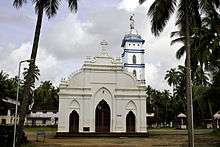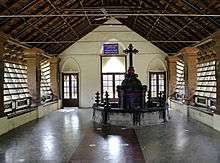Palayoor


Palayoor is famous for its Christian church, St. Thomas Church which is founded by St. Thomas the Apostle in 52 AD. It was the first Christian Church in India. St. Thomas, the Apostle, arrived in 52 AD at Crangannur {now Kodungallur} with Jewish merchants for the propagation of Christ’s message and through the sea route reached Palayoor in 52 AD and built the Church here. Palayoor also had an ancient Jewish settlement known as the Jews' Hill. Palayoor was connected from the first century onwards even up to this day to other ancient trade centres of Kerala, especially Muziris, by rivers and backwaters. The river and backwater system in the erstwhile Cochin State opens out into the sea at Chettuwaye, Cranganur and Cochin with the three Thomas churches at Palayoor, Kodungallur, and Parur connected together by this system. People from far off lands have found their way to Kerala and to Palayoor since ancient times. The coast was familiar country to the Phoenicians, the Romans, the Arabs and the Chinese long before Vasco da Gama arrived in 1498.
History
Palayur was the stronghold of the Namboodiri Brahmins (the highest caste in Indian communities). When St. Thomas arrived from Kodungallur, Israelites had a settlement at Palayur, two thousand years ago. Ruins of an ancient Jewish synagogue are still seen outside of a Brahmin temple about a furlong away from the Church. "When Thomas came to the great Brahmin centre of Palayur, a leading Brahmin Gramam (village) among the 64, he came across some Brahmins doing the Pithru Yajna or Pooja to the manes or ghosts of deceased ancestors. They were throwing water into the air (Tharpan) while reciting manthras. The Apostle learned from them the meaning of this ritual and remarked: "If your performance is acceptable to the gods they could keep the water suspended in the air without allowing it to fall again and again". "The Brahmins said that this was unthinkable as it was opposed to the laws of nature. Then Thomas asserted that the One true God he worshipped could do it, and he proceeded to perform a miracle on condition that the Brahmins accept his faith if he is successful. The Apostle, invoking the Holy Spirit, made the sign of the Cross and threw a handful of water up into the sky. After reaching a particular height the water stood still in the air, the particles glittering like diamonds. Looking down the Brahmins could see the cavity made by the removal of the water still there in the pond. Most of the witnesses were baptised on the spot. Although this historical legend has been told and re-told by many people in India, a verification of this legend being known outside India, produced no confirmation. The Synaxarion compiled by the Monastery of Simonos Petra on Mt. Athos, as well as an English translation of Dmitri of Rostov's 17th century Great Collection of The Lives of the Saints, which are multi-volume collections and are extremely detailed and have been checked for an account of this miracle, but there is no such evidence.
St. Thomas Syro-Malabar Church

St. Thomas Syro-Malabar Catholic Church, Palayoor is unique in that the present church has a continuous history of two millennia and stands on the same spot where the apostle first established it. The first church founded by St. Thomas continued to exist for many centuries and we know that in 1607 the Italian Jesuit Fr. Fenichi with Permission from the ecclesiastical authorities, to construct a more convenient church around the existing old structure for the parish of Palayur.
The Thrissur Archdiocesan authorities are today wholeheartedly committed to the cause of developing Palayur into the focus of national and international pilgrim tourism in South India. The Palayur church was elevated as the first Archdiocesan pilgrim centre on 16 April 2000. The relic of St. Thomas conveyed from Ortona, Italy was established in the main altar of the church. The 30 km long annual Lenten Mahatheerthadanam or great pilgrimage on foot from the Thrissur to Palayur has conducted in every year.[1]
Thaliyakulam

St Thomas saw Bhramins doing Pooja in this pond, throwing water into the air (Tharpan) while reciting manthras. The Apostle learned from them the meaning of this ritual and remarked: ‘If your performance is acceptable to the gods they could keep the water suspended in the air without allowing it to fall again and again’. "The Brahmins said that this was unthinkable as it was opposed to the laws of nature. Then Thomas asserted that the One true God he worshipped could do it, and he proceeded to perform a miracle on condition that the Brahmins accept his faith if he is successful. The Apostle, invoking the Holy Trinity, made the sign of the Cross and threw a handful of water up into the sky. After reaching a particular height the water stood still in the air, the particles glittering like diamonds. Looking down the Brahmins could see the cavity made by the removal of the water still there in the pond.
How to reach
Palayoor is a part of Trichur District and is located on the west Cost of Kerala. By road it takes 28 km to reach Palayur from Trichur. It is on Trichur – Chavakkad route, via Pavaratty. To travel by train catch Trichur – Guruvayur train (24 km). From Guruvayur to Palayoor take a bus or a taxi/auto rickshaw (2 km). Nedumbasserry International Airport is only 80 km from Palayoor.
Road
Buses ply regularly between Palayoor/Chavakkad/Guruvayoor/Thrissur and all major towns in Kerala and South India.
- From the North: Kuttippuram-Kunnamkulam-Chavakkad-Palayoor
- From the South: Kodungallur-Chettuva-Chavakkad-Palayoor
- From the East: Thrissur-Kanjany-Enammavu-Pavaratty-Palayoor
- N.B. Chavakkad Palayur distance: 0.75 km
- Guruvayur Palayur distance: 2.00 km
Train
Direct trains connect Thrissur with all major Indian cities like Delhi, Bombay, Calcutta, Madras, Bangalore, Coimbatore, Trivandrum..... Some trains proceed from Thrissur up to Guruvayur.
- N.B. Thrissur railway station is 25 km from Palayur
- Guruvayur railway station is 3 km from Palayur
Air
- Palayur is equidistant (less than 90 km) from the following airports:
- Kochi International Airport, Nedumbassery
- Calicut International Airport, Karippur
- Coimbatore Airport is 140 km from Palayoor
See also
Monuments at Palayoor
- Boat Jetty (Bottukulam) where St Thomas landed at Palayoor.
- Thaliyakulam -The pond where St Thomas baptized the local people.
- The replica of Chinna Malai (of Mylapore – Madras) where St Thomas attained martyrdom in 72 AD.
- The historical remnants of old Aryan Temple.
- Historical Museum.
References
- ↑ "PALAYUR CHURCH, CHAVAKKAD". thrissurkerala.com. Retrieved 2014-06-06.
External links
| Wikimedia Commons has media related to Palayoor. |
Coordinates: 10°34′57″N 76°01′55″E / 10.5825°N 76.0319°E